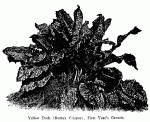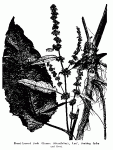Yellow Dock. Rumex crispus L.
 OTHER COMMON NAMES—Rumex, curled dock, narrow dock, sour dock.
OTHER COMMON NAMES—Rumex, curled dock, narrow dock, sour dock.
HABITAT AND RANGE—This troublesome weed, introduced from Europe, is now found thruout the United States, occurring in cultivated as well as in waste ground, among rubbish heaps and along the road side.
DESCRIPTION OF PLANT—Yellow Dock is a perennial plant belonging to the buckwheat. family (Polygonaceae), and has a deep, spindle shaped root, from which arises an erect, angular and furrowed stem, attaining a height of from 2 to 4 feet. The stem is branched near the top and leafy, bearing' numerous long dense clusters formed by drooping groups of inconspicuous green flowers placed in circles around the stem. The flowers are produced from June to August, and the fruits which follow are in the form of small triangular nuts, like the grain of buckwheat, to which family the dock belongs. So long as the fruits are green and immature they can scarcely be distinguished from the flowers, but as they ripen the clusters take on a rusty brown color. The leaves of the yellow dock are lance shaped, acute, with the margins strongly waved and crisped, the lower long-stalked leaves being blunt or heart shaped at the base from 6 to 8 inches in length, while those nearer the top are narrower and shorter, only 3 to 6 inches in length, short stemmed or stemless.
 The broad-leaved dock (Rumex obtusifolius L.), is known also as bitter dock, common dock, blunt-leaved dock, and butter-dock, is a very common weed found in waste places from the New England States to Oregon and south to Florida and Texas It grows to about the same height as the yellow dock, to which it bears a close resemblance, differing principally in its more robust habit of growth. The stem is stouter than in yellow dock and the leaves, which likewise are wavy along the margin, are much broader and longer. The green flowers appear from June to August and are in rather long, open clusters, the groups rather loose and far apart.
The broad-leaved dock (Rumex obtusifolius L.), is known also as bitter dock, common dock, blunt-leaved dock, and butter-dock, is a very common weed found in waste places from the New England States to Oregon and south to Florida and Texas It grows to about the same height as the yellow dock, to which it bears a close resemblance, differing principally in its more robust habit of growth. The stem is stouter than in yellow dock and the leaves, which likewise are wavy along the margin, are much broader and longer. The green flowers appear from June to August and are in rather long, open clusters, the groups rather loose and far apart.
DESCRIPTION OF ROOTS—Yellow Dock root is large and fleshy, usually from 8 to 12 inches long, tapering or spindle shaped, with few or no rootlets. When dry it is usually twisted and prominently wrinkled, the rather thick, dark, reddish brown bark marked with small scars. The inside of the root is whitish at first, becoming yellowish. The fracture is short, but shows some splintery fibers. The root, as it occurs in commerce, is either entire or occasionally split lengthwise.
The darker colored root of the broad-leaved dock has a number of smaller branches near the crown and more rootlets. Dock roots have but a very faint odor and a bitter, astringent taste.
COLLECTION, PRICES AND USES—The roots should be collected in late summer or autumn, after the fruiting tops have turned brown, then washed, either left entire or split lengthwise into halves or quarters and carefully dried. Yellow Dock root ranges from 4 to 6 cents a pound.
In the United States Pharmacopoeia of 1890 "the roots of Rumex crispus and of some other species of Rumex" were official and both of the above-named species are used, but the Yellow Dock (Rumex crispus) is the species most commonly employed in medicine. The docks are largely used for purifying the blood and in the treatment of skin diseases.
The young root leaves of both of the species mentioned are sometimes used in Spring as pot herbs.
Ginseng and Other Medicinal Plants, 1936, was written by A. R. Harding.

